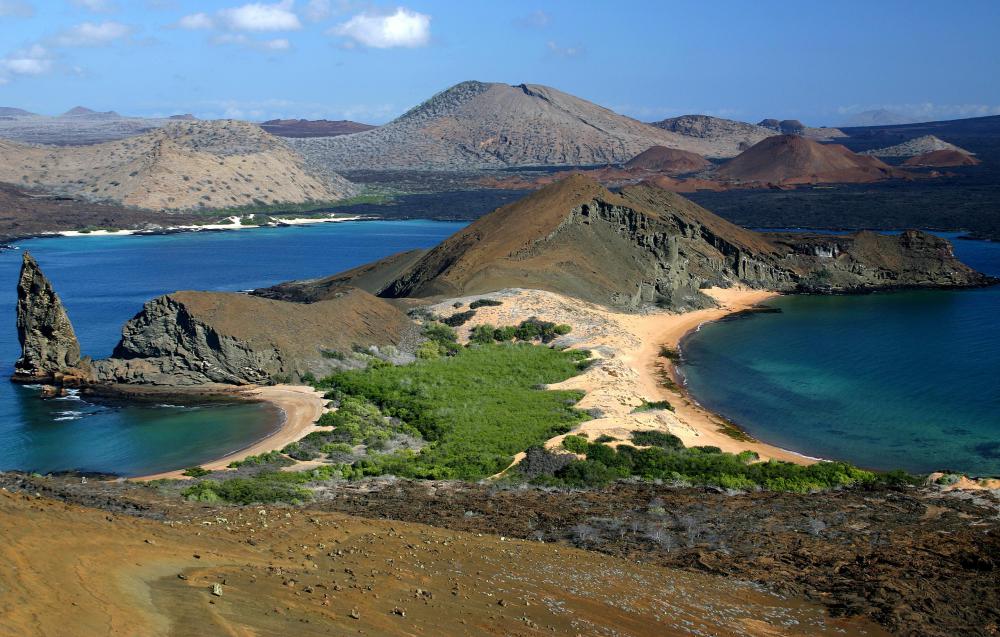At AllThingsNature, we're committed to delivering accurate, trustworthy information. Our expert-authored content is rigorously fact-checked and sourced from credible authorities. Discover how we uphold the highest standards in providing you with reliable knowledge.
What is a Pink Iguana?
The pink iguana is a rare type of land iguana first spotted in 1986 on a specific volcano called Volcan Wolf in the Galapagos Islands of Ecuador. This endangered iguana was not officially documented as a unique species until 2009 and has slightly pink skin and is genetically different from other iguanas that are typically green or yellow in color.
The Galapagos are volcanic islands in the Pacific Ocean located just off the western Ecuadorian coast near the equator. The islands are famous as a sight rich in unique endemic species and as a place visited by Charles Darwin in 1835 while the scientist was voyaging on the HMS Beagle ship. Darwin did not visit Volcan Wolf while conducting his survey of the Galapagos and thus did not witness the pink iguana in its limited habitat.

It is believed that the pink iguana species split from an ancestor common to land and marine iguanas more than 10.5 million years ago, possibly before many of the current Galapagos Islands had formed, and is likely the oldest iguana species on the archipelago. Since Volcan Wolf is approximately 350,000 years old, the pink iguana likely had a different habitat in the past before migrating to its current territory. The pink iguana’s limited habitat makes it vulnerable to the effects of human hunting, excess tourism and invasive species such as feral goats and as a result is considered to be critically endangered.

The pink iguana has black stripes down its back and is also known as the rosada, Spanish for pink, species. These lizards can grow to more than 3 feet (1 meter) in length, weigh approximately 26 pounds (12 kilograms) and live to be 60 years old. The Galapagos iguanas are cold blooded and must absorb heat daily by sunning themselves on volcanic rock and conserving body heat at night by sleeping in burrows. Its diet is herbivorous, but it showcases opportunistic carnivorous behavior such as eating carrion and insects when needed. Green iguanas are popular exotic pets in the United States and other countries.
Despite some similarities between all the Galapagos iguana species, the pink iguana can be differentiated by its pink skin, head scales, prominent crest and its unique head bobbing behaviors. Iguanas typically bob or nod heads when courting mates or disputing territory and while the pink iguana’s motivations may be similar, its head bobbing display pattern is particular. A pink iguana moves its head in a series of rapid up and down bursts of motion that no other iguana species mimics. It is possible that this head bobbing is also done as a greeting or a warning.
Frequently Asked Questions
What is a Pink Iguana?
The Pink Iguana, scientifically known as Conolophus marthae, is a rare species of land iguana found exclusively on the Galápagos Islands. Discovered in 1986 and formally described in 2009, it is distinguished by its pink coloration and unique genetic traits. This iguana is critically endangered, with a population limited to the Wolf Volcano on Isabela Island.
Why is the Pink Iguana pink?
The Pink Iguana's distinctive coloration is due to a genetic mutation affecting skin pigmentation. Unlike their green cousins, pink iguanas have a reduced amount of melanin, which results in their pinkish hue. This trait is unique to the species and is one of the key characteristics that differentiate it from other land iguanas in the Galápagos.
How many Pink Iguanas are there in the wild?
As of the latest surveys, the Pink Iguana population is estimated to be fewer than 200 individuals. This critically endangered species faces threats from volcanic activity, invasive species, and climate change. Conservation efforts are crucial to prevent their extinction, as they are one of the most threatened reptiles on the Galápagos Islands.
What do Pink Iguanas eat?
Pink Iguanas are herbivores, primarily feeding on a variety of plants and vegetation native to the Galápagos Islands. Their diet consists of leaves, flowers, and fruits, which they forage from the ground and low-lying vegetation. This diet is essential for their survival in the harsh volcanic environment they inhabit.
Are Pink Iguanas different from other iguanas?
Yes, Pink Iguanas are genetically distinct from other land iguanas found in the Galápagos. They belong to a separate species and are not just a color variant. Their genetic divergence is significant, indicating that they have been evolving independently for more than five million years, according to genetic studies.
What conservation efforts are in place for Pink Iguanas?
Conservation efforts for Pink Iguanas include habitat protection, invasive species control, and scientific research to better understand their ecology and genetics. The Galápagos National Park Directorate, along with various international conservation organizations, is actively working to protect this species and its habitat from further degradation.
AS FEATURED ON:
AS FEATURED ON:












Discuss this Article
Post your comments